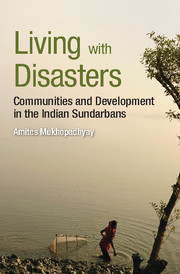Book contents
- Frontmatter
- Dedication
- Contents
- Maps and Illustrations
- Tables and Charts
- Glossary
- Acronyms
- Acknowledgements
- Note on Transliteration
- Maps
- Illustrations
- Charts
- 1 Introduction
- 2 From Wasteland to Wonderland: The Making of a Heritage Site
- 3 Governing the Sundarbans Embankments Today: Between Policies and Practices
- 4 Treading a Fine Path between River and Land: Livelihoods around Embankment
- 5 Beldars, Embankment and Governance: Question of Aboriginality Revisited
- 6 Catching Prawn, Endangering Embankments: Sustainability-Unsustainability Rhetoric
- 7 Conclusion
- Bibliography
- Index
4 - Treading a Fine Path between River and Land: Livelihoods around Embankment
Published online by Cambridge University Press: 05 March 2016
- Frontmatter
- Dedication
- Contents
- Maps and Illustrations
- Tables and Charts
- Glossary
- Acronyms
- Acknowledgements
- Note on Transliteration
- Maps
- Illustrations
- Charts
- 1 Introduction
- 2 From Wasteland to Wonderland: The Making of a Heritage Site
- 3 Governing the Sundarbans Embankments Today: Between Policies and Practices
- 4 Treading a Fine Path between River and Land: Livelihoods around Embankment
- 5 Beldars, Embankment and Governance: Question of Aboriginality Revisited
- 6 Catching Prawn, Endangering Embankments: Sustainability-Unsustainability Rhetoric
- 7 Conclusion
- Bibliography
- Index
Summary
Island, stakeholders and location
As development thinking has moved from ‘thing-oriented’ to ‘people-oriented’ paradigm (Chambers 1995), it has thrown up a number of terms such as ‘poor’ (World Bank 1996a), ‘poorest of the poor’ (Harris 1988; Singh 1988), ‘indigenous people’ or ‘communities’ (United Nations 1993), ‘beneficiaries’ (Paul 1987; World Bank 1996b), ‘stakeholders’ (Nelson and Wright 1995; World Bank 1996b; Jeffery and Sundar 1999; Vedeld 2001) and so on to refer to people. The ‘poor’ are defined as people living in remote and impoverished areas (World Bank 1996a, 7). The term ‘stakeholders’ has been further classified into ‘primary stakeholders’ referring to people or direct beneficiaries and ‘secondary stakeholders’ including government agencies and NGOs (Vedeld 2001, 6). A question that arises is who these ‘stakeholders’ or ‘poorest of the poor’ are. How does one understand these meta-categories in a particular context? The chapter is an attempt to answer these questions.
Like other southernmost Sundarbans islands, Kusumpur also has mud quays or embankments encircling and protecting the islands. A part of Kusumpur island is connected with the landmass of Gosaba island that comes under Gosaba block and constitutes a separate village panchayat. A road from Gosaba market leads to Kusumpur and then branches off into two directions, one going in the direction of Jagatpur and the other leading through south Kusumpur towards a van rickshaw stand (where van rickshaws are parked) next to Kusumpur High School. Beyond this van rickshaw stand are the winding embankments serving as pathways connecting Jaipur, Ramnagar and heavily eroded north Kusumpur to south Kusumpur. These embankment paths in most parts of the island are so narrow that van rickshaws cannot ply on them. People mostly walk or use bicycle to travel to their destinations. There are stretches where embankments become so narrow and breached that even cycling proves difficult. People get off their cycles and walk through that particular stretch of embankment path carrying the cycles on their shoulders. Embankments are always higher than the ground level of the inhabited islands to protect them against flooding during high tide when water rises higher than the islands. Embankments, when viewed from inside the villages, look like mud walls with people using the slope of the wall to ascend and descend.
Branching off in horizontal lines from the embankment at regular intervals elevated mud tracks pass through the interior of the island.
- Type
- Chapter
- Information
- Living with DisastersCommunities and Development in the Indian Sundarbans, pp. 73 - 93Publisher: Cambridge University PressPrint publication year: 2016



